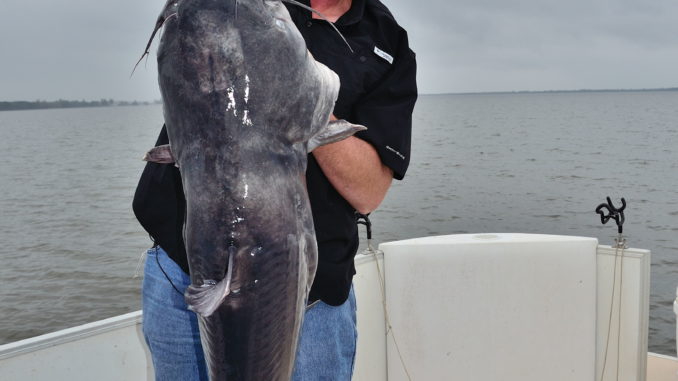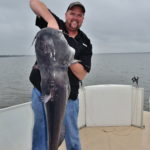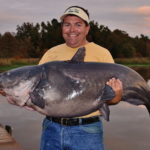
With winter on the horizon, the best catfishing of the year approaches on the Santee Cooper lakes in South Carolina. Here’s how to get in on wonderful whiskered action.
As the holiday season nears, outdoor lovers gravitate towards an early morning duck hunt or a last-minute sit in their favorite deer stands. But if you’ve got a fishy state of mind, winter is prime time to lock onto a trophy catfish, and there’s no place better than Santee Cooper’s Lake Moultrie and Lake Marion.
The Santee Cooper system is often dubbed as the best catfish fishery in the country and for good reason. The watershed is responsible for producing South Carolina’s state record cats: 79-pound flathead, 109-pound blue and 58-pound channel catfish that is also the all-tackle world record.
As water temperatures creep lower, the chances of boating a trophy fish becomes real. Guide Linwood Thornhill said winter is when the big girls show up on a consistent basis.
“The best time to catch big catfish is between November and January. We see the 70- to 90-pound fish this time of year,” said Thornhill, who said anglers’ chances go up because big fish are congregated in the lakes’ deeper regions. “All catfish — especially the big ones — are concentrated at certain depth, and that makes the chances of taking a bigger fish much better.”
Like most predators, food dictates a catfish’s travels. While they are opportunistic feeders, baitfish are their No. 1 source of nourishment. When temperatures fall, baitfish respond by retreating to deeper areas where the temperature is more stable and conducive for survival. And that rings the dinner bell for catfish.
“When the weather gets cold, catfish follow the bait into deep water, and the bait balls up in tight schools,” said Thornhill, who concentrates on areas between 35 and 65 feet deep on the lower end of Lake Moultrie toward Pinopolis Dam.
“The winter fishing is the best on the east side of Marker 10 towards the dam and Bonneau,” he said.
Fish will not always be confined to one area or structure type even in this particular area. Thornhill prefers to concentrate on ledges near deep water or flats depending on where the bait is balled up. Wherever the bait is concentrated will be the place to fish.
Gene Crawford, who also guides out of Black’s, said he relies on his boat’s electronics to point out where the cats are living.
“We keep a sharp eye on our depth finder during the winter, because when the bait is thick, the catfish will be there,” Crawford said. “When we pass over a big catfish, you can usually see them on the screen and sometimes on the hook a few minutes later.”
Crawford generally starts fishing along the top of ledges and moves into the deeper sections if needed — and depending on what size fish his clients are after.
“We usually find the smaller fish on the shallower side and the larger fish on the deeper sides of the ledges. The bait is usually suspended over the deeper sections, and the biggest catfish are beneath them,” he said. “Experience tells you where to start, and then the electronics take over. If you find the bait, you will find the big cats.”
Baitfish and catfish will stage at different places throughout the winter, and those places can often change from day to day, which makes electronics, mobility and adaptability very important.
Guides like Crawford and Thornhill leave their anchors secured in their lockers in December and adopt a slow, drifting technique. After finding a good concentration of bait, Thornhill will move upwind and drift through the bait with weighted lines bumping the bottom.
“We take long drifts, and other times we take short drifts to make sure we stay in the fish. As long as the fish are still biting, we will keep on drifting,” Thornhill said.
Typically, the majority of the catfish bite will be blues, with a few channel cats mixed in. But the bite can be steady and fierce, according to Crawford.
“When the water cools down, the blues and channel cats feed heavily. They aren’t bothered by the cold at all. If anything, they are more aggressive,” he said.
It’s prime time to catch a big Santee Cooper cat that can push the scales out to 80 to 90 pounds or more.
“They are concentrated in a limited area and at limited depths. The chances of taking a bigger fish in December and January are much better than any other time of year,” Thornhill said.
DESTINATION INFORMATION
HOW TO GET THERE — I-95, I-26 and US 52 offer good access to Lake Moultrie and Lake Marion through Manning, Moncks Corner and Santee. More than 100 public and private boat-access areas are available. Visit www.santeecoopercountry.org/lakeside-facilities.html.
WHEN TO GO — Catfish can be caught year-round, but the winter smackdown begins when the water temperatures drop into the 60s or lower. The best winter fishing is between the middle of November and the end of February.
BEST TECHNIQUES — Catfish feed heavily during the winter; almost any type of bait will put fish on the hook, but live herring and chunks of saltwater mullet are preferred. While catfish are concentrated on the lower end of the two lakes, that’s a lot of water to cover. For the best results, anglers should use high-definition depth finders equipped with down-scan and side-scan technology to locate the highest concentrations of bait. These types of electronics are critical equipment for getting right on the highest concentrations of catfish. Anglers should drift baits just off the bottom using the slinky weight-cork rigs. Slow drifts are important and drift socks should be used to control speed.
FISHING INFO/GUIDES — Gene Crawford, Gene’s Guide Service, 843-560-0600; Linwood Thornhill, Linwood’s Guide Service, 843-509-8174. See also Guides and Charters in Classifieds.
ACCOMMODATIONS — Black’s Camp, 843-753-2231, www.blackscamp.com; Santee Cooper Country, www.santeecoopercountry.org; S.C. Association of Visitors Bureaus, www.discoversouthcarolina.com.
MAPS — Navionics, www.navionics.com; DeLorme’s S.C. Atlas & Gazetteer, 207-846-7000, www.delorme.com; Atlantic Mapping, www.atlanticmapping.com.







Be the first to comment